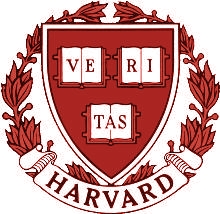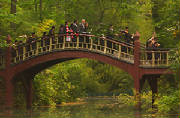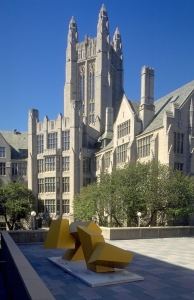|
The first three colleges were Harvard, William and Mary, and Yale. They were adjuncts to their respective churches
and were created in the tradition of the English institutions of Cambridge and Oxford.

Harvard was chartered on October 28, 1636. In 1639, it was named Harvard College after John Harvard, since he left
his library and half of his estate to the college.
In 1640, Henry Dunster became the first President. He modeled the curriculum after the English universites.
In 1642, 9 people graduated with undergraduate degrees. Harvard created the first Professorships of Divinity (1721)
and Mathematica and Natural Philosophy (1727).
The administration was bicameral. It had a board of overseers, which consisted of magistrates and clergy, and the
Harvard Corporation, which consisted of the President, five fellows, and a treasurer.

|
| Graduating seniors from William & Mary Class of 2005 cross the Crim Dell Bridge |
William and Mary was chartered on February 8, 1693 and was named after King William III and Queen Mary II.
The school was also formally linked with the Church of England.
James Blair was President from 1693-1743. The administration was bicameral, because it had a state Board of
Trustees and the faculty body.
In 1729, the Board of Trustees followed the plan of giving full control to the faculty body.

Yale was chartered in 1701 as the Collegiate School. It became Yale College in 1718, because Elihu Yale donated
books and goods to the college. Thomas Clap became the Fifth Rector and First President of the school in 1745 and stayed
in the presidency until 1766.
The administration was unicameral since it was run by the Yale Corporation and clergy. In 1745, the president became
the ranking member.
The Harvard, William and Mary, and Yale curriculum included:
- liberal education
- classical languages
- 3 basic philosophies of Aristotle (ethics, metaphysics, and natural philosophy)
- focus on educating ministers
- Two-thirds of Harvard graduates in the 17th century entered the ministry
- Non-ministareal students were welcome
|
